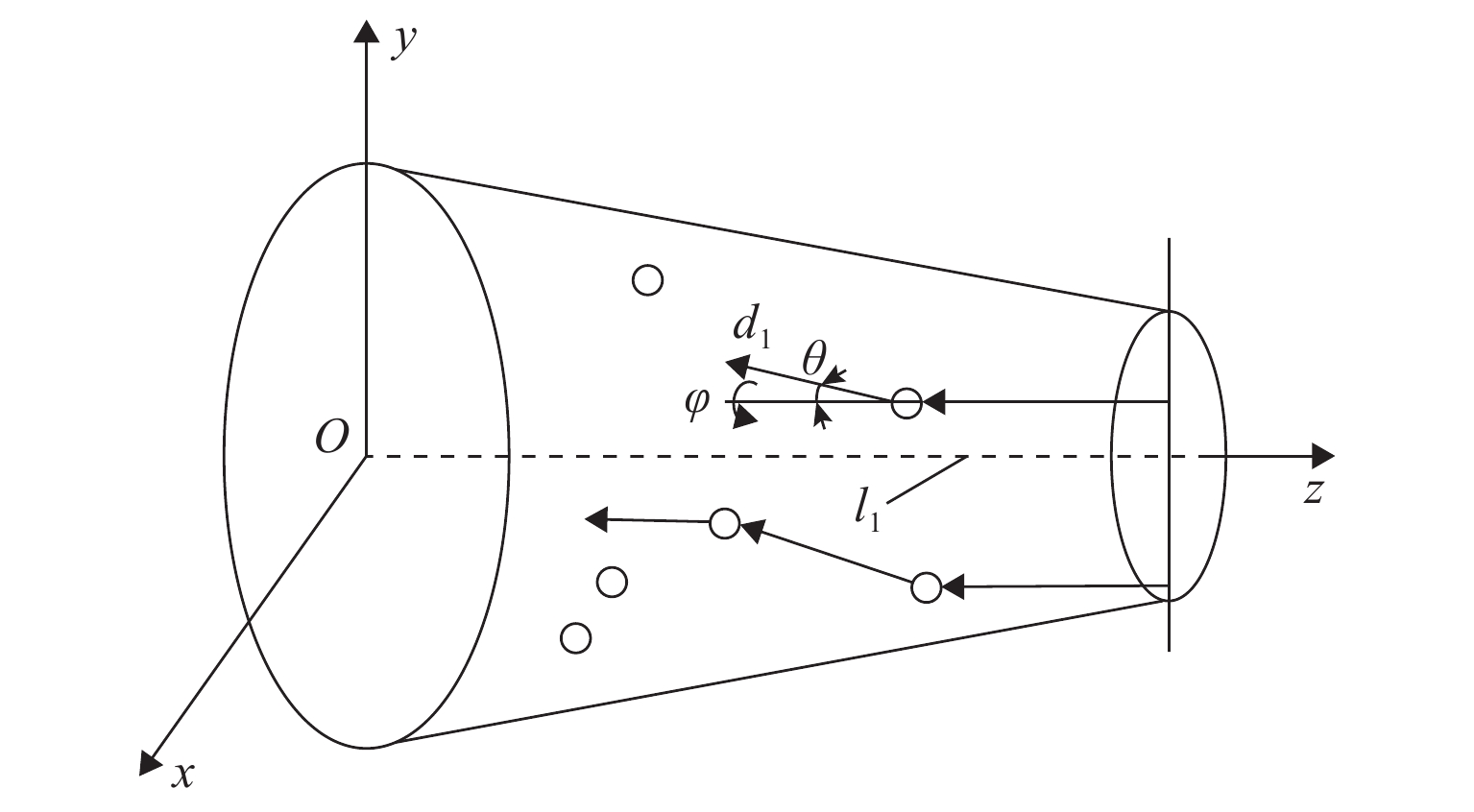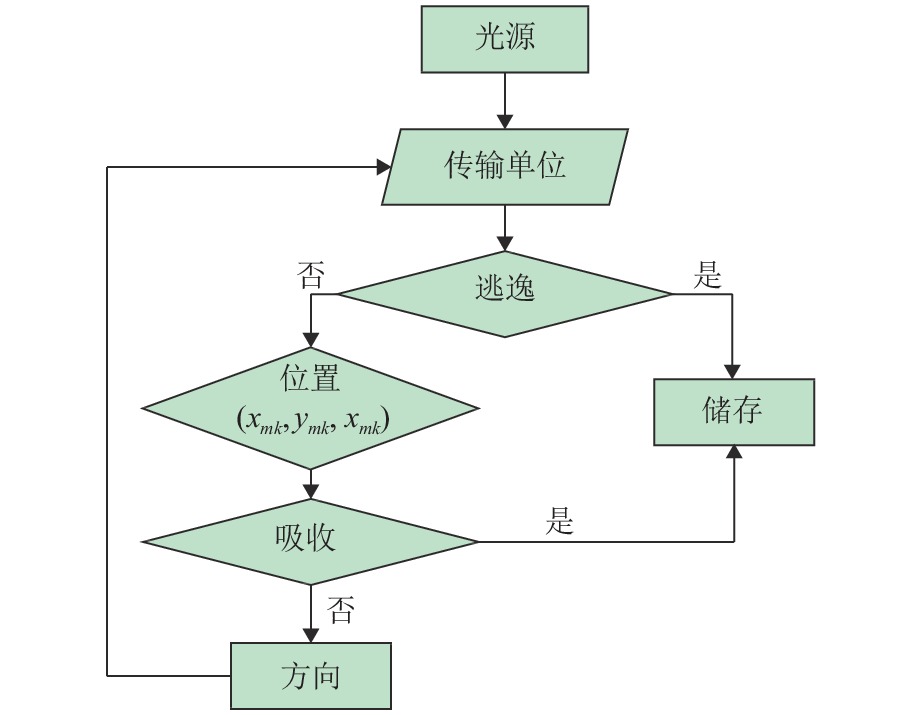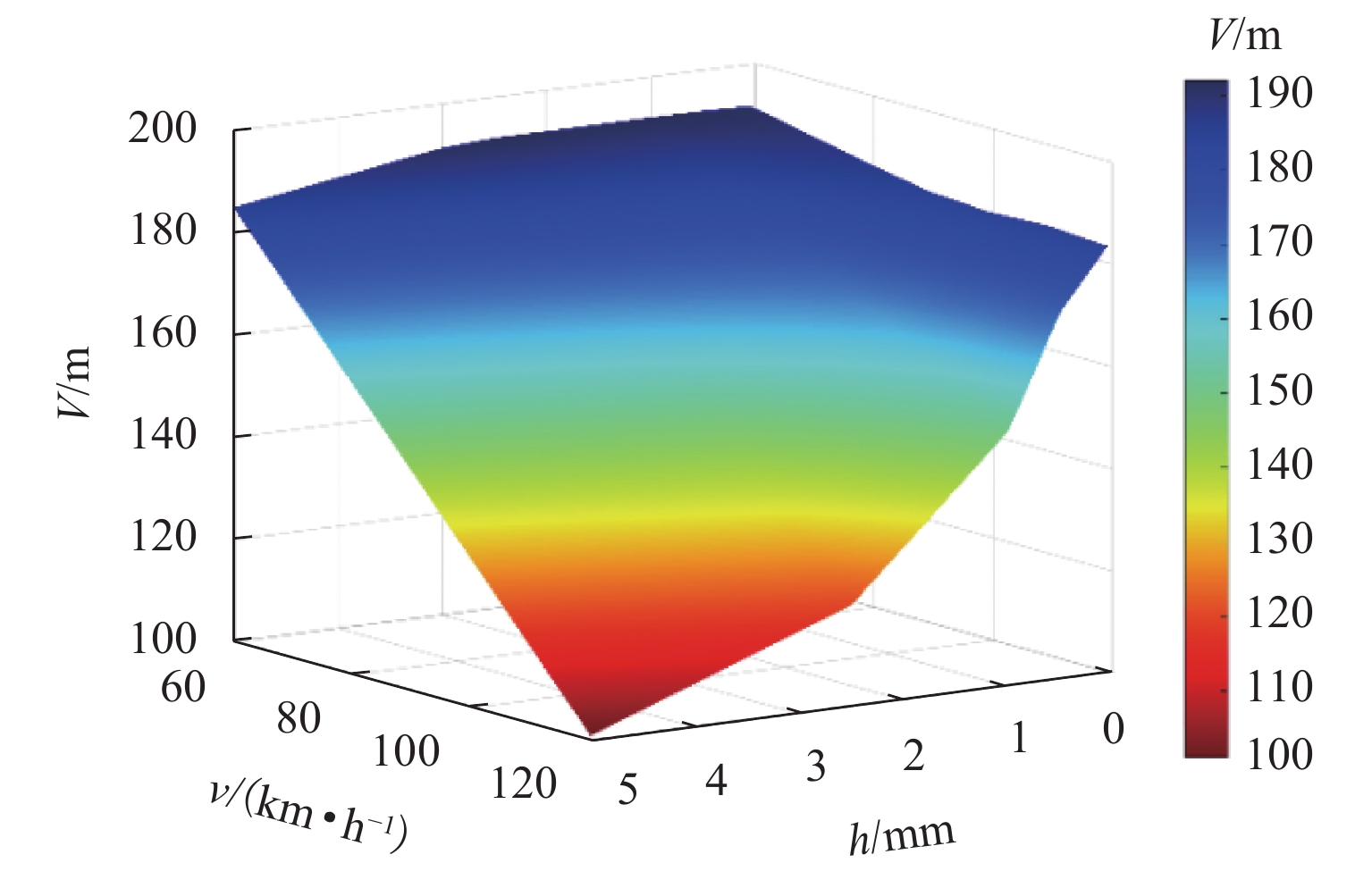Influencing Factors of Asphalt Pavement Visibility on Rainy Days
-
摘要:
在降雨情况下,汽车行驶过程轮胎所溅起的水花极易形成水雾,前方能见度会显著下降,人体主观的识别距离也随之迅速减小,甚至出现对行车间距的错误判断,易造成交通事故,研究雨天沥青路面能见度影响因素意义重大. 以米氏理论为基础,利用能见度的气象学定义,并采用MATLAB软件进行蒙特卡罗数值模拟,提出了用车速、水膜厚度和路面设计参数表征的能见度计算模型,进而对能见度影响因素进行了分析. 结果表明:在雨天,沥青路面水膜厚度低于5.873 mm时,水雾引起的能见度会随车速和水膜厚度增加而不断减小;路面设计参数中,排水路径长度、路面构造深度与能见度呈正相关性;路面坡度与能见度呈负相关性;在水膜厚度为5.873 mm时能见度达到极小值;进一步提出了用降雨强度、路面构造深度、路面坡度、排水路径长度和车速表征的沥青路面能见度改进计算模型.
Abstract:Under the condition of rainfall, the water spray splashed by the tires of vehicles during driving can easily form water mist, and the visibility in front will be significantly reduced. The subjective recognition distance of the human body will be rapidly reduced, and even the wrong judgment of driving distance will lead to traffic accidents. Therefore, it is of great significance to study the influencing factors of asphalt pavement visibility on rainy days. Based on Mie’s theory, the meteorological definition of visibility was utilized, and Monte Carlo numerical simulation was performed with MATLAB software. In addition, a visibility calculation model is put forward characterized by vehicle speed, water film thickness, and pavement design parameters and then analyzed the influencing factors of visibility. The results show that on rainy days, when the water film thickness of asphalt pavement is less than 5.873 mm, the visibility caused by water mist will decrease with the increase in vehicle speed and water film thickness; among the pavement design parameters, the length of drainage path and the depth of pavement structure are positively correlated with visibility, and there is a negative correlation between road slope and visibility. It is found that the visibility reaches the minimum when the water film thickness is 5.873 mm; an improved calculation model of asphalt pavement visibility characterized by rainfall intensity, depth of pavement structure, pavement slope, length of drainage path, and vehicle speed is proposed.
-
Key words:
- visibility /
- traffic safety /
- asphalt concrete /
- Monte Carlo simulation /
- pavement
-
表 1 能见度数值模拟数据汇总表
Table 1. Summary of visibility numerical simulation data
m 水膜厚度/mm 60 km/h 70 km/h 80 km/h 90 km/h 100 km/h 110 km/h 120 km/h 0.050 191.78 189.35 186.93 184.73 183.98 184.45 183.70 0.100 191.80 189.20 186.60 184.20 183.20 183.40 182.40 0.200 191.85 188.90 185.95 183.15 181.65 181.30 179.80 0.500 192.00 188.00 184.00 180.00 177.00 175.00 172.00 1.000 192.00 185.00 178.00 171.00 164.00 157.00 150.00 1.500 192.00 184.00 175.67 167.00 158.00 149.00 140.00 2.000 192.00 183.00 173.33 163.00 152.00 141.00 130.00 2.500 192.00 182.00 171.00 159.00 146.00 133.00 120.00 3.000 191.40 179.80 168.20 155.8 142.60 129.40 116.20 4.000 188.20 175.40 162.60 149.400 135.80 122.20 108.60 5.000 185.00 171.00 157.00 143.00 129.00 115.00 101.00 表 2 能见度状态划分标准
Table 2. Division standard of visibility state
序号 能见度
距离/km技术标准 1 ≥50.00 能见度极好,视野清晰 2 [20.00,50.00) 能见度好,视野较清晰 3 [10.00,20.00) 能见度一般 4 [2.00,10.00) 能见度较差,视野不清晰 5 [1.00,2.00) 轻雾,能见度差,视野不清晰 6 [0.20,1.00) 大雾,能见度很差 7 [0.05,0.20) 重雾,能见度极差 8 < 0.05 浓雾,能见度极差 表 3 不同车速下能见度与水膜厚度关系汇总
Table 3. Summary of functional relationship between visibility and water film at different vehicle speeds
v/(km·h−1) V 与 h 函数关系式 R2 60 $ V=-0.536\;9{h}^{2} + 1.386\;7h + 191.52 $ 0.982 70 $V={189.74\mathrm{e} }^{-0.02h}$ 0.985 80 $V={186.5\mathrm{e} }^{-0.035h }$ 0.991 90 $V={183.3\mathrm{e} }^{-0.053h }$ 0.982 100 $V={181.02\mathrm{e} }^{-0.075h }$ 0.967 110 $V={179.71\mathrm{e} }^{-0.101h }$ 0.957 120 $V={177.63\mathrm{e} }^{-0.129h }$ 0.955 表 4 蒙特卡罗数值模拟能见度汇总
Table 4. Summary of Monte Carlo numerical simulation visibility
m h/mm v/(km·h−1) 60 70 80 90 100 110 120 0.050 191.78 189.35 186.93 184.73 183.98 184.45 183.70 0.100 191.80 189.20 186.60 184.20 183.20 183.40 182.40 0.200 191.85 188.90 185.95 183.15 181.65 181.30 179.80 0.500 192.00 188.00 184.00 180.00 177.00 175.00 172.00 1.000 192.00 185.00 178.00 171.00 164.00 157.00 150.00 1.500 192.00 184.00 175.67 167.00 158.00 149.00 140.00 2.000 192.00 183.00 173.33 163.00 152.00 141.00 130.00 2.500 192.00 182.00 171.00 159.00 146.00 133.00 120.00 3.000 191.40 179.80 168.20 155.80 142.60 129.40 116.20 4.000 188.20 175.40 162.60 149.40 135.80 122.20 108.60 5.000 185.00 171.00 157.00 143.00 129.00 115.00 101.00 表 5 能见度拟合多元非线性回归方程函数组合方式汇总
Table 5. Summary of combination methods of multiple nonlinear regression functions for visibility fitting
编号 f(h) 函数形式 g(v) 函数形式 V 的拟合方程 1 $D{h}^{2} + Eh + F$ $D{h}^{2} + Eh + F$ $V=A \left(D{h}^{2} + Eh + D\right) +B \left(D{h}^{2} + Eh + F\right) + C$ 2 $D{h}^{2} + Eh + F$ $G{ {\rm{e} } }^{v}$ $V=A \left(D{h}^{2} + Eh + F\right) + BG { {\rm{e} } }^{v} + C$ 3 $D{h}^{2} + Eh + F$ $H\mathrm{ln}\;v$ $V=A \left(D{h}^{2} + Eh + F\right) + BH \mathrm{ln}\;v + C$ 4 $J{ {\rm{e} } }^{h}$ $G{ {\rm{e} } }^{v}$ $V=AJ { {\rm{e} } }^{h} + BG { {\rm{e} } }^{v} + C$ 5 $J{ {\rm{e} } }^{h}$ $H \mathrm{ln}\;v$ $V=AJ { {\rm{e} } }^{h} + BH \mathrm{ln}\;v + C$ 6 $J{ {\rm{e} } }^{h}$ $D{h}^{2} + Eh + F$ $V=AJ { {\rm{e} } }^{h} + B \left(D{h}^{2} + Eh + F\right) + C$ 7 $K\mathrm{ln}\;h$ $G{ {\rm{e} } }^{v}$ $V=A K\mathrm{ln}\;h + BG { {\rm{e} } }^{v} + C$ 8 $K\mathrm{ln}\;h$ $H\mathrm{ln}\;v$ $V=AK \mathrm{ln}\;h + BH \mathrm{ln}\;v + C$ 9 $K\mathrm{ln}\;h$ $D{h}^{2} + Eh + F$ $V=AK \mathrm{ln}\;h + B \left(D{h}^{2} + Eh + F\right) + C$ 表 6 第3种函数组合数学统计特征值表
Table 6. Statistical eigenvalues of the third function combination
源 平方和 自由度 均方 回归 2194427.100 4 548606.8 残差 7402.174 73 101.4 修正前总计 2201829.200 77 修正后总计 43037.038 76 表 7 第3种函数组合参数估算值
Table 7. Estimated values of the third function combination parameters
参数 估算 标准误差 95% 置信区间 下限 上限 A 1.275 0.498 0.283 2.267 B −14.977 2.406 −19.771 −10.182 C −67.797 4.985 −77.732 −57.861 D 490.392 22.407 445.735 535.048 表 8 第3种函数组合参数估算值相关性
Table 8. Correlation of estimated values of the third function combination parameters
参数 B C A D B 1.000 0 −0.954 −0.071 C 0 1.000 0 −0.995 A −0.954 0 1.000 0.056 D −0.071 −0.995 0.056 1.000 表 9 国内外水膜厚度预测模型汇总表
Table 9. Summary of water film thickness prediction models in China and abroad
模型名称 模型形式 模型参数 水膜
厚度路径
长度降雨
强度路径
坡度路面构造
深度曼宁
系数季天剑模型[17] $h=0.130\;6{l}^{0.722\;4}{i}^{0.303\;9}{q}^{0.772\;5}{ T_{\rm{TD} } }^{0.673\;0}$ h/mm l/m q/(mm·min−1) i/% TTD/mm RRL 模型[18] $d=0.046 L^{0.47} I^{0.47} S^{-0.2} $ d/mm L/m I/(mm·h−1) S/% Gallaway 模型[19] $W_{\rm{WFT} }=0.0148\;5 { T_{\rm{TXD} } }^{0.11} L^{0.43} I^{0.59} S^{-0.42}-{T_ {\rm{TXD} } }$ WWFT/mm L/m I/(mm·h−1) S/% TTXD/mm Wambold 模型[20] $W_{\rm{WFT} }=0.005\;979 {T_{\rm{TXD} }}^{0.11} I^{0.59} S^{-0.42}-T_{\rm{TXD} }$ WWFT/mm L/m I/(mm·h−1) S/% TTXD/mm Anderson 模型[21] $d=0.15 L^{0.5} I^{0.5} S^{-0.5} $ d/mm L/m I/(mm·h−1) S/% VERT 模型[22] $W_{ {\rm{WD} } }=0.016\;405 L^{0.4} I^{0.4} {M_{\rm{MTD} } }^{0.4} S^{-0.3}$ WWD/mm L/m I/(mm·h−1) S/% MMTD/mm Chesterton 模型[23] $W_{\rm{WFT}}=0.046 L^{0.5} I^{0.5} S^{-0.2}-T$ WWFT/mm L/m I/(mm·h−1) S/% TTXD/mm NCHRP 模型[24] $W_{\rm{WFT} }=\left(\dfrac{n L I}{105.425 S^{0.5} }\right)^{0.6}-T$ WWFT/mm L/m I/(mm·h−1) S/% TTXD/mm n -
[1] 孙悦. 海绵型道路关键几何设计参数优化及雨天行车安全研究[D]. 南京: 东南大学, 2019. [2] 曹雪娟. 雾环境下山区高速公路驾驶员动态视认特性研究[D]. 重庆: 重庆交通大学, 2015. [3] KONSTANTOPOULOS P, CHAPMAN P, CRUNDALL D. Driver’ s visual attention as a function of driving experience and visibility. Using a driving simulator to explore drivers’ eye movements in day, night and rain driving[J]. Accident Analysis and Prevention, 2010, 42(3): 827-834. doi: 10.1016/j.aap.2009.09.022 [4] PENG Y H, ABDEL-ATY M, SHI Q, et al. Assessing the impact of reduced visibility on traffic crash risk using microscopic data and surrogate safety measures[J]. Transportation Research Part C: Emerging Technologies, 2017, 74: 295-305. doi: 10.1016/j.trc.2016.11.022 [5] 刘春媛. 基于激光大气透射仪的能见度测量误差研究[D]. 天津: 中国民航大学, 2016. [6] 高国强. 雨雾天环境中对激光传输衰减的研究[D]. 西安: 西安科技大学, 2014. [7] YU B, SUN Y. Simulation of impact of water-film spray on visibility[J]. Journal of Transportation Engineering Part B: Pavements, 2018, 144(4): 04018054.1-04018054.7. [8] 张义. 低能见度下山区高速公路行车安全影响及保障技术研究[D]. 重庆: 重庆交通大学, 2017. [9] 戢晓峰,张琪,覃文文,等. 恶劣天气对高原山区高速公路交通流特征的影响分析[J]. 交通信息与安全,2020,38(4): 10-16.JI Xiaofeng, ZHANG Qi, QIN Wenwen, et al. An impact analysis of bad weather on traffic flow characteristics of plateau mountain expressway[J]. Journal of Transport Information and Safety, 2020, 38(4): 10-16. [10] 范新南,冶舒悦,史朋飞,等. 改进大气散射模型实现的图像去雾算法[J]. 计算机辅助设计与图形学学报,2019,31(7): 1148-1155.FAN Xinnan, YE Shuyue, SHI Pengfei, et al. An image dehazing algorithm based on improved atmospheric scattering model[J]. Journal of Computer-Aided Design & Computer Graphics, 2019, 31(7): 1148-1155. [11] 冯文燕,张存保,曹雨,等. 雾天区域高速公路网交通运行状态建模与分析[J]. 武汉理工大学学报(交通科学与工程版),2021,45(1): 93-98.FENG Wenyan, ZHANG Cunbao, CAO Yu, et al. Modeling and analysis of traffic state of regional freeway network in fog region[J]. Journal of Wuhan University of Technology (Transportation Science & Engineering), 2021, 45(1): 93-98. [12] HUANG Y, YAN X D, LI X M. Using a multi-user driving simulator system to explore the patterns of vehicle fleet rear-end collisions occurrence under different foggy conditions and speed limits[J]. Transportation Research Part F:Traffic Psychology and Behaviour, 2020, 74: 161-172. doi: 10.1016/j.trf.2020.08.025 [13] 姚镇海,周建平,邱新法. 基于高速公路视频图像的能见度计算[J]. 南京信息工程大学学报(自然科学版),2019,11(1): 85-90.YAO Zhenhai, ZHOU Jianping, QIU Xinfa. Visibility calculation algorithm based on highway video image[J]. Journal of Nanjing University of Information Science & Technology (Natural Science Edition), 2019, 11(1): 85-90. [14] PALVANOV A, CHO Y. VisNet: deep convolutional neural networks for forecasting atmospheric visibility[J]. Sensors, 2019, 19(6): 1343-1376. doi: 10.3390/s19061343 [15] 石玉立,王彬,卜帆. 基于图像特征的大气能见度估算方法[J]. 南京理工大学学报(自然科学版),2018,42(5): 552-559.SHI Yuli, WANG Bin, BU Fan. Atmospheric visibility measurement based on image feature[J]. Journal of Nanjing University of Science and Technology, 2018, 42(5): 552-559. [16] 余乐,吴国雄,何兆益. 山地城市全透水沥青路面结构力学响应分析[J]. 公路,2021,66(11): 1-7.YU Le, WU Guoxiong, HE Zhaoyi. Analysis of structural mechanical response of fully permeable asphalt pavement in mountain city[J]. Highway, 2021, 66(11): 1-7. [17] 季天剑. 降雨对轮胎与路面附着系数的影响[D]. 南京: 东南大学, 2004. [18] RUSSAM K, ROSS N F. The depth of rain water on road surfaces[R]. London: Road Research Laboratory, Ministry of Transport,1968. [19] GALLAWAY B M, ROSE J G. The effects of rainfall intensity, pavement cross slope, surface texture, and drainage length on pavement water depths[R]. Washington D. C.: Federal Highway Administration, 1972. [20] WAMBOLD J C, HENRY J J, HEGMON R R. Evaluation of pavement surface texture significance and measurement techniques[J]. Wear, 1983, 83(2): 351-368. [21] ANDERSON J A. Depth of rain water on road surface[J]. Highways and Transportation, 1995, 42(5): 45-49. [22] MANCOSU F, PARRY A, TORRE F L. Friction variation due to speed and water depth[C]//Fourth International Symposium on Pavement Surface Characteristics on Roads & Airfields. Nantes: PIARC,2000: 249-258 . [23] CHESTERTON J, NANCEKIVELL N, TUNNICLIFFE N. The use of the gallaway formula for aquaplaning evaluation in New Zealand[C]//Transit NZ and NZIHT 8th Annual Conference. Vermont South: ARRB Group Limited,2006: 1-22. [24] ANDERSON D A, HUEBNER R S, REED J R, et al. Improved surface drainage of pavements[R]. Washington D. C.: Transportation Research Board, 1998. -





 下载:
下载:




